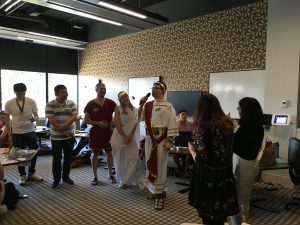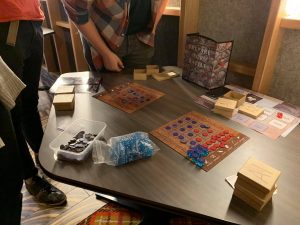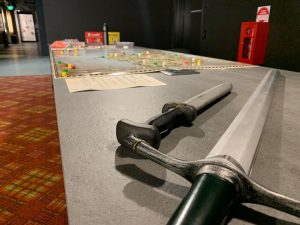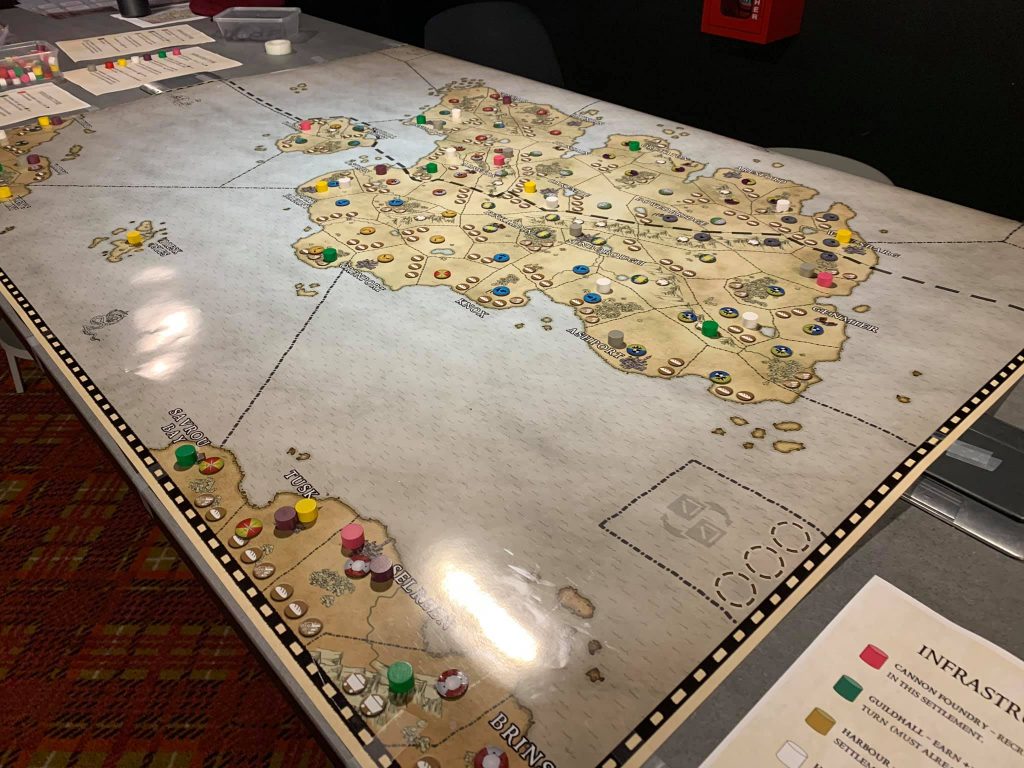The Path of (re)Design, Pt. III
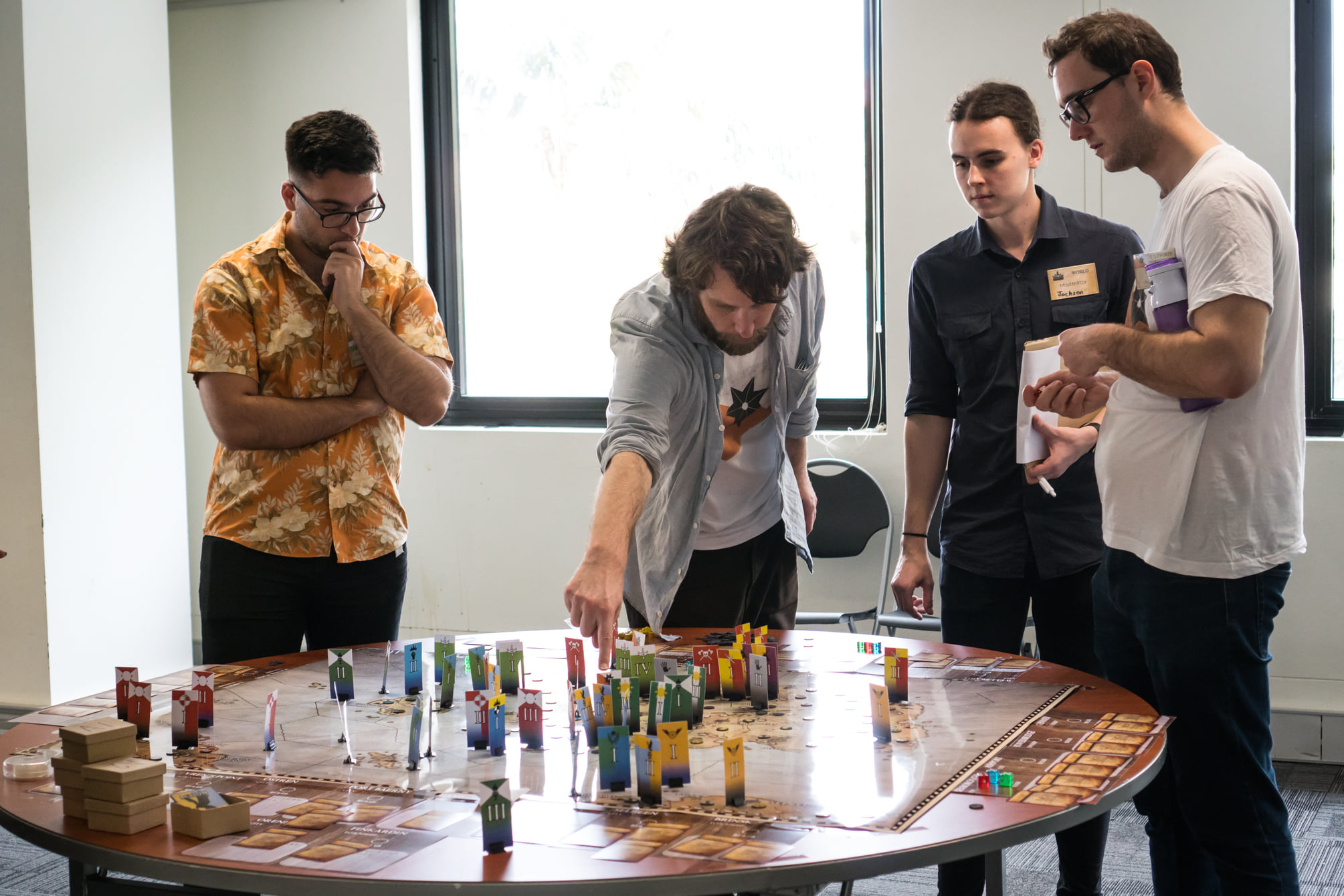
Miss the start of this series? Check our Part I and Part II for more on the re-design process.
Finally we reach the end of my thought-dump, now that the slashed and changed components of For the Crown have been covered. In this write-up, instead, I wanted to run through some of the secrets For the Crown had hidden away in its design. Most were revealed in the second run, as it happened, while remaining hidden during the first.
I think this is in part due to luck, but also part due to players having far more detail on their plate in the original run of the game in Sydney – with so much to track and manage, they had no time to learn secrets!
Monarchy
As many probably expected, For the Crown had a mechanism which allowed players to re-take the throne and ascend to monarchical rule. This never formally happened to the chosen heirs in the first game – they were all assassinated before a Council could vote them to power – and did unravel in a surprising way in the second run of the game.
The idea of establishing a new monarchy in the game required significant support from a Council. Both the North and South of Wruicia had capacity for a monarch – their occupants simply needed to agree, and vote on, who that should be.
In the first game the secret heirs to the throne were cast players, solo’s who were not aligned to any team (and one particular player who manufactured his own background and came within inches of the crown). In the second game, several players were given a tap on the shoulder prior to Turn 1, but they were embedded in the normal teams and it was emphasised that pursuing the claim was entirely up to them.
In both runs of the game, though, the result of taking the throne was the same – a new set of rules came into effect. This only became reality in the 2.0 version of the game – in fact, it happened a number of times.
Once a Council had agreed to establish someone as their Monarch, that individual (representing their team) would become the permanent chair of the Council. They would set the agenda, and they would also determine who could and couldn’t attend meetings (and thus vote).
All teams which owned territory in the Monarch’s lands (North or South) had to pay taxes to the new King or Queen each turn. Further, the Monarch was now able to raise their own armies, no longer capped at a single military unit on the map.
Of course, there was always a way to bring a monarchy crashing down. Other teams were able to vote the Monarch out of a Council (which would only succeed if they were able to surprise their new leader, as they’d simply be banned from attending if the monarch saw the coup coming), but also launch military resistance against the new crown.
Overall, the monarchy system in practice added little mechanical bite to the game, but definitely enhanced the roleplay and storytelling for those involved. The second run of the game saw a number of monarchs rise to power, one even taking control of both the North and South for a short time, and solidified some great moments of narrative.
New Units
The second big reveal I had planned from very early in the design process was the introduction of new units throughout the game. Warfare is a major part of the game and, while the diversity of units is already broad, I figured nothing would force the players to think on their feet more than the introduction of new units in the middle of the game.
In the first game, new units were just about shelved the moment the game had begun. It was quickly evident there was too much detail and information for players, let alone Mods, to manage. Adding new military modifiers and special mechanics wouldn’t add much joy to the game – it would just slow things down.
In the second game, with some of the fat cut, I implemented special units as part of the trade route mechanic. Teams which controlled certain nodes at the right time would gain access to exotic new military units, shipped in from a foreign land far away. These units didn’t require the usual upkeep and their production was entirely in Gold – no food, timber or metals required.
The main imported unit was War Elephants, powerful cavalry units which had ridiculous dice modifiers and the ability to scare the enemy away. It was possible, through a few well rolled attacks, to reduce the enemy force by half simply by forces their front lines to retreat.
In addition, though, there was always a risk that the elephant units would cause more havoc than they were worth. On poor rolls, players would witness the creatures trample their own units or cause their soldiers to flee. After all, Wruicians are accustomed to fighting alongside elephants as much as they to fighting against them – not at all!
At several other moments I introduced other units through special events – players would interact with me, or another Mod, with an offer of help from some other minor faction in the world. In return for a new fighting force, though, the team was often asked for something quite valuable in return.
This was usually how the Exiles came in – barbaric, wild folk, arguably custodians of Wruicia, who had some significant fighting power and some outlandish ideas. On several occasions teams were offered an army of these Exiles in return for the mission to attack a particular location on the map which held significance to the custodial people. These units were powerful with their rolls and had the ability to attack diagonally, not just directly forward, which made them unpredictable.
The use of these new units was successful – they added a new flavour to the world and the lore, while giving players more to think about in combat. Tactics needed to be changed, rumours about new units spread throughout the game organically, and everyone was always dreading seeing an elephant token during their opponent’s deployment.
I think there would be room for more nuanced military units, or abilities, in future iterations of this type of game. For the Crown evidently became quite a combat-heavy game, which I think many players enjoyed, and throughout design we dropped a lot of ideas (such as unique units to each team) due to their complexity. Maybe, in future, more advanced version of the FtC military game, I might explore some of these ideas.
Seasons
Finally come the seasons, something that remained hidden away in both runs of the game despite my intentions. It was an early (and obvious) idea to include seasonal change in the game when each turn was a month.
In the setting, the change of the seasons would have obvious impact on the economies and diplomatic relations of nation-states around the world – a good harvest was a blessing, a chilling winter a challenge, and summer storms could wreak havoc on naval operations.
In both runs of design I had a cheat sheet of hidden modifiers for every single Turn – army movement, food income, trade possibilities, infrastructure disasters… they were all covered in the background by seasonal mechanics. Negatives, like those winter might cause to crops, were designed to slowly implement over multiple turns so that players could plan and try to adapt to them.
Like many facets of the game, seasonal modifiers were simply too detailed for too little gain. During the first run of the game, like special military units, the seasonal modifiers were dropped before Turn 1 began.
In the second run, after considering simplifying the seasonal rules down to simple changes every 3 months (3 turns, instead of every turn), I still ended up scrapping the plan by the time the game was in action.
As with many facets of the game which I removed, or downsized, seasonal mechanics simply lacked immersion and impact on the broader game for the amount of effort they required to facilitate. I’ve learned a lot about these types of mechanics and would be keen to revisit season-based mechanics in future, designing them to be more focussed as plot devices than simply modifiers to existing mechanics.
That's it! A (long-delayed) reflection on what it takes to rework a game. I don't think For the Crown is perfect, however I do think the experience - for both those running the game and those playing it - was drastically improved through the re-design process.
There's still plenty of room to move within the confines of this design - ideas that were on the backburner from day one, or new mechanics which simply weren't explored due to lack of time. A megagame, like any piece of creative art, could no doubt refined and retuned and rework to perpetuity.
For this one, though, I'm happy to close the book, learn many lessons from the experience, and move onto whatever might be next...

